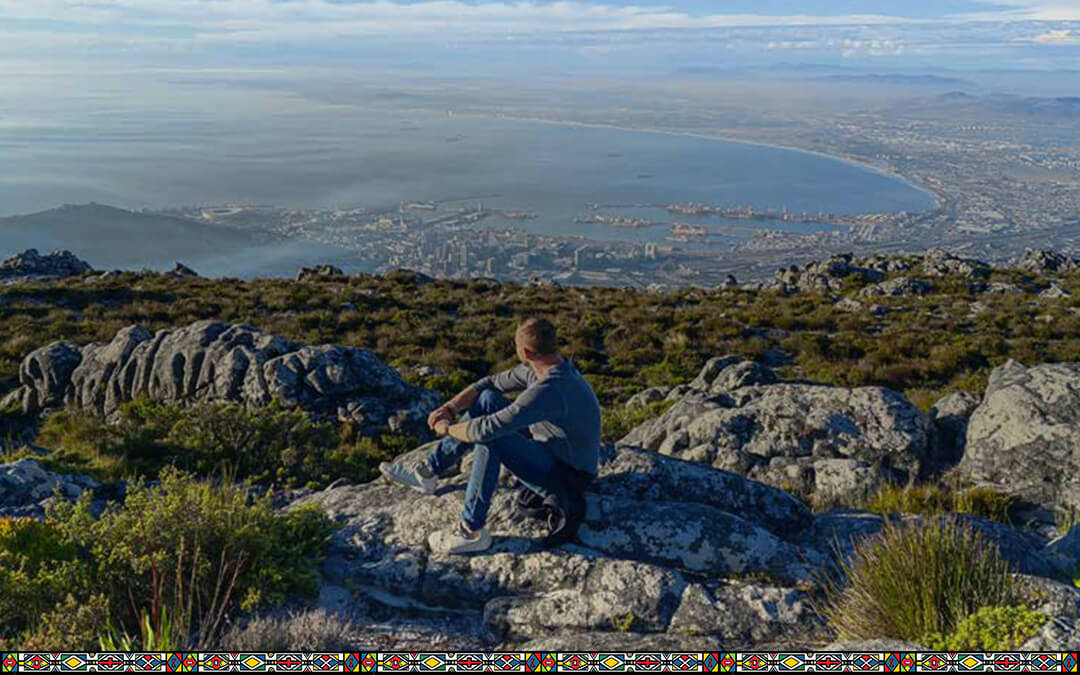In terms of motorcycling, South Africa has never been a “bucket list” destination for me. Probably just because there are so many other beautiful places on earth that I would have liked to have “pulled in” first. Quite a few have already been done! The countries of Europe, the Wild West of America with Route 66, the line of whisky and music from Chicago to New Orleans, the jungles of Asia in Thailand, Malaysia. Old plan Turkey, the Caucasus countries…
South Africa came up against me!
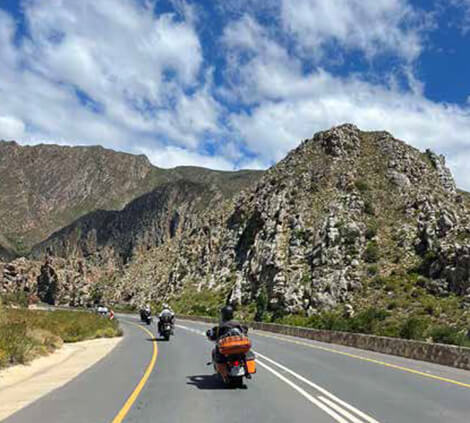
In February last year, (2023) a SOUTH AFRICAN tourism agency was one of the guests at the Travel exhibition,
who was promoting the beauty of the country with great enthusiasm, but of course, they had no plans to organize motorbike tours there in the near future. We started talking and in the end we decided to organise a motorcycle team to show them the southern part, with Cape Town, the famous geographical points (Cape of Good Hope, Cape Agulhas), the equally famous wine-, and brandy regions, wild ocean cliffs, beautiful canyons and vast savannahs.
It turned out that they had a colleague who used to lead motorbike tours there, and we immediately started to draw the route on the map, we had in mind. We quickly plotted the sights we wanted to see, which resulted in a 2.000 km tour from Cape Town east to Port Elizabeth (Gqeberha) and back. Touching all the beautiful things, mountains, passes, ocean beaches.
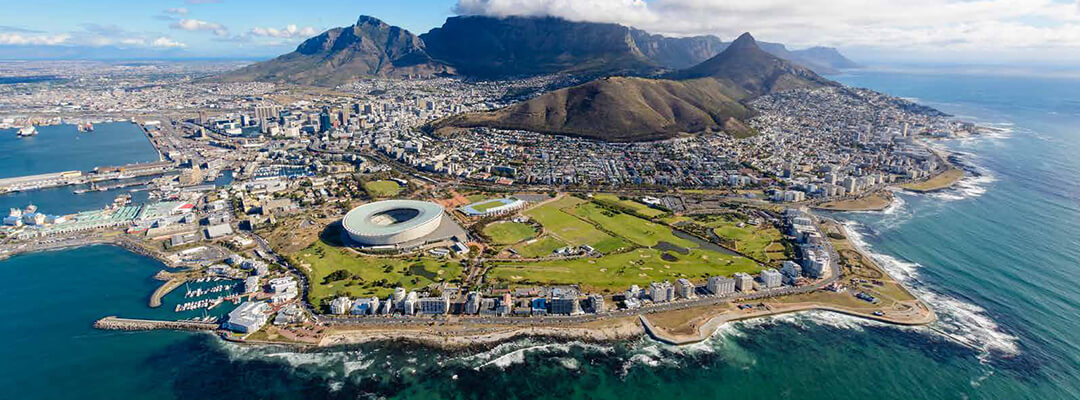
By October, the schedule and program was set:
14 days, including travel, of which 9 days motorcycling. We organised a presentation for my biker friends – the South African agency done it so thoroughly that we even got special pictures of the bathrooms in the hotels – and by the end of it we had the team. We had set a limit of 14 people, but we ended up with 18. Mostly “harlis”, “goldwingers”, “bmws”. Cape Town GS Africa provided the rental bikes. With perfect service! What we chose at home, we got. If they didn’t have it in stock, they got it. On delivery, the name of the “hiring” owner was written on the plexiglass of each bike. All bikes rolled out of the factory after a very thorough inspection (a series of photos and a report, which we received immediately by mail). 4 Harley Davidson (Ultras) and 5 BMWs (1200GS/750GS). Joe, our tour leader, drove the team on a Suzuki V-Storm. We left a deposit of 1100€ for the smaller bikes and 1400€ for the bigger ones.
Then on 4 January we boarded our Turkish flight
and after a total flight of 14 hours we arrived in Cape Town. It was a very interesting feeling that despite the long flights, the difference between Budapest and Cape Town was only 1 hour, as we crossed the African continent almost straight from north to south. Even though it was summer, we were not all greeted by sweltering heat – much to the delight of the locals – and in fact, we took almost everything with us on the first few days. But at the end of the tour, the +35 degrees did show.
My special request was that the accommodations during the tour should be very varied, if possible extreme, as we are in Africa after all… And so we were. We slept in a downtown multi-star, rural – very rural, far from everything, very remote area, a hundred-year-old Victorian ranch house, a luxury safari tent and a very elegant vintage ranch.

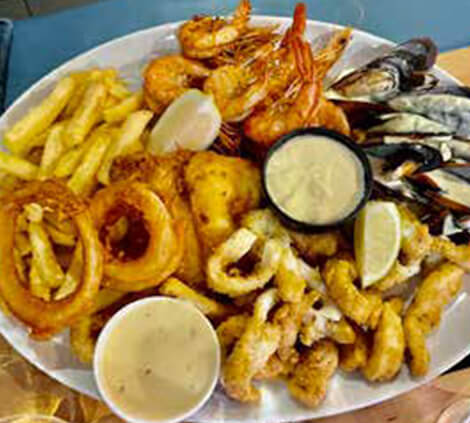
We started in a five-star hotel on Baauwberg Beach in Cape Town,
opposite us we saw Table Mountain. The Atlantic Ocean water was unsuitable for swimming for us due to its coldness, but this didn’t bother the local beachgoers at all. The life went on, music played on the beach, kites flew in the wind, and the local forces – mostly black guys – patrolled up and down in their tuned-up cars. Of course, on the first evening, we had to taste South Africa’s basic culinary gems of steak (beef/ostrich/kudu) and seafood. And then we followed the same thereafter: morning, noon and night. A 300 gram medium steak with a side dish and a beer (Windhoek) cost a little less than a menu at MacDonalds at home… Well, please, that is Africa!
Speaking of Windhoek: I mean the beer, because there are other interesting facts. Well, it’s the most popular beer in South Africa, even though it’s not from the own country, but from its neighbouring one, Namibia. (The capital city of Namibia called Windhoek, the same name as the beer.) Or rather the other way round! It is a bIt turned out that they had a colleague who used to lead motorbike tours there, and we immediately started to draw the route on the map, we had in mind. We quickly plotted the sights we wanted to see, which resulted in a 2.000 km tour from Cape Town east to Port Elizabeth (Gqeberha) and back. Touching all the beautiful things, mountains, passes, ocean beaches.
At home, when I said where I was going to, the first question was almost always: “Oh, my God, isn’t that a dangerous place?”
Yes, it is. Only, if you go to where you’re not advised to fo. Like everywhere else in the world. Here at home, it is the same, too.
Of course, the situation there is certainly different, than average, the contrast is also greater, with huge black masses living in “tin towns”, unemployment is high, white people`s houses guarded by electric fences, banks guarded by armed guards. With Nelson Mandela’s presidency (1994), after the first free elections, apartheid was abolished. Local whites said that they had some fears for the future, but Mandela , as a politician with a keen sense of politics, was able to create some unity. The country has been ruled by a black government ever since and the people there, black, white or coloured, would like very much to have another Mandela!
Economy
South Africa has one of the most industrially, technologically advanced economies on the continent. It has an enormous mineral wealth (e.g. coal, uranium, diamonds, platinum, iron, chromium, copper, etc) and 45% of the world’s gold reserves. Around Johannesburg, more than 200 coal mines are still in operation today, producing black gold. Despite the high labour absorption capacity of big industry, unemployment is high, which of course creates antagonisms – most simply put – between whites and blacks. This can be seen in everyday life, for example, in the burglar-proof electric wires that run along the top of the fences surrounding white people’s houses, like an impenetrable wall…
Indigenous people of South Africa
The indigenous people of South Africa were neither blacks nor whites, but the Bushmen. (“Gods fell on their heads!”) Blacks are not indigenous either. Their tribes migrated from Central Africa, herding their animals and leading a nomadic lifestyle to the south. It was only in the late fifteenth century that whites first came to the south. The people who live there now are descendants of Dutch farmers, English sailors who call themselves Afrikaners. They also speak the language, which is a real mixture. Mostly Dutch, but with traces of English and German. Coloured are the ‘common product’ of whites and blacks. They have slightly yellowish skin, very short and curly hair. The beautiful Coloured women won more of the time the title of the world’s beauty for South Afrika.
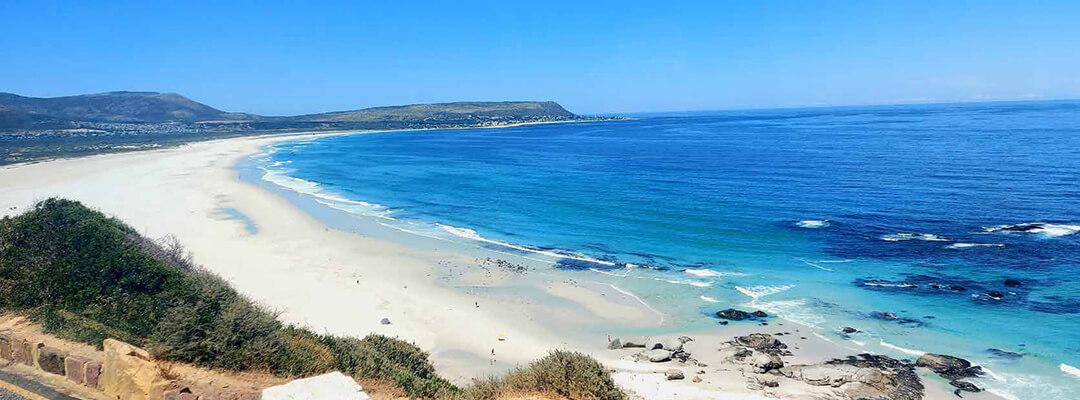
After picking up the bikes, we prepared ourselves and went for a bike around Cape Town and the surrounding area,
to get used to left-hand traffic. Joe, our guide – ex motorcycle cop – rode in front and we followed him perfectly secure. He instructed us with his arm-movements to guide us what to do on the roads. True, the orange warning sign “KEEP LEFT, LOOK RIGHT” was on all motorists` windscreen of every bike, but the first roundabout – without Joe – would have certainly fooled the team. The “all-to-everywhere-with all” traffic-principle is not known here, it seems more European habit and idea, there was no special respect for motorcyclists, like sometimes, back at home…
We left the city heading south, passing the beautiful yellow sandy Hout Bay Beach, to turn onto one of the country’s most beautiful scenic drives, Chapman’s Peak Drive. We were fortunate to be able to drive up the road, which winds along the ocean and has 121 beautiful bends, and it must closed in high winds/storms. This was the first time in the world that the sides of the rocky mountain slips were fenced with a special material to protect the drivers from rockfalls (this innovation was later adopted by the Europeans, who used it on the roads in the Alps)-We then crossed over to the eastern side of the peninsula to see the South African penguins at Boulders Beach. A large colony lives here, completely free in their own natural environoment. Interestingly, the wooden platform leading to their nest, is not on the ground, but lifted from ground at a height of 1-2 metres, giving the penguins more space to move around. It was here first time, that I saw the penguins sitting on their egg, in a constant battle with the sea-gulls that are trying to pinch their eggs. A French lady standing next to me felt so protective of them that she almost called the police to arrest the seagull immediately.
Then my heart began to beat faster as we headed towards Cape Point and the Cape of Good Hope. No wonder, I was going to see the two most spectacular points on Earth! The beautiful sight, and the fact that I was standing on the spot that everyone in the sixth grade had heard about, touched by Bartalomeo Diaz, Vasco da Gama and all those who came after them, was enough to make me speechless! The cliffs, which by by passing them brought hope in the sailors`s hearts on their way home.
The next day we set off. The 10 motors in front, followed by the escort/supporting car full of luggage
We came to Africa, but there was no sign of the humid, stifling heat, in fact! The proximity of the ocean brought us a constant wind and towering rain clouds, the latter of which we fortunately avoided.
According to our itinerary we were travelling on a route similar of a figure of number eight. We were heading towards Port Elizabeth (now Gqeberha), meandering sometimes along the ocean shore, sometimes in the mountains. We didn’t visit Kenya or Zimbabwe, but we did visit all the major attractions of South Africa’s southernmost coast. We fed sharks in Gansbaai. Well, not me, but the brave ones. In fact, it wasn’t the animals that kept me from diving, but the cold water. It was more a diving feeding the sharks. a dive feeding. This meant that the brave men in neoprene suits would climb into a water cage, which they would then lift from the boat into the 15 degree water with their heads still above water. If they wanted to face the sharks they had to dive under. The bate which was made of pink fish meat, were poured into the water and soon the sharks arrived in regular order. Of course, everyone was expecting the big white sharks, but they were busy somewhere else. We were still happy with the beautiful grey sharks of two metres and longer. We had a plan to use drones for pictures, but the cheeky free-feaster seagulls attacked the drone with such force that we thought it better to blow retreating.
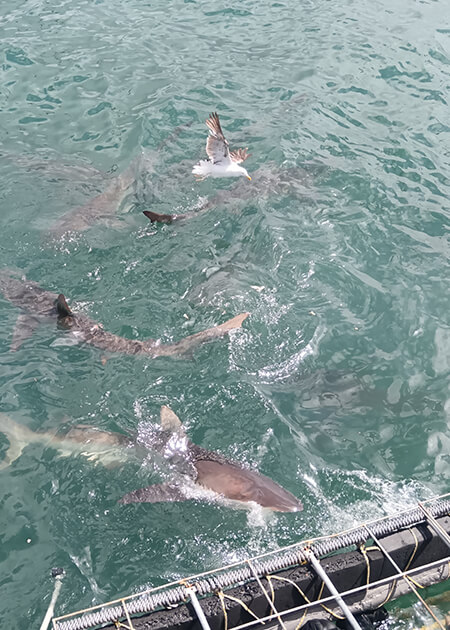
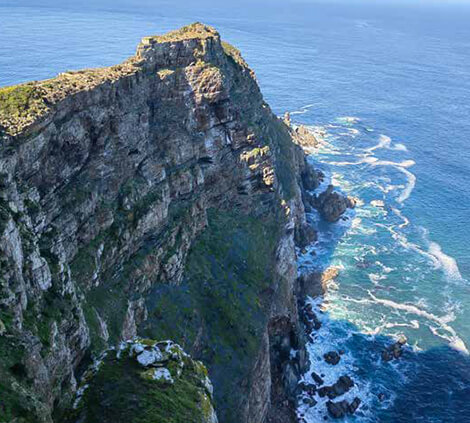
From here it was just a short jump to reach Cape Agulhas.
This is the southernmost point and the rockiest stretch of coastline in Africa, where the Atlantic and Indian Oceans meet. It is said that between Cape of Good Hope and “Cape of Needles”,Cape Agulhas the distance only over 100 km out on sea, still there are lying more than 120 shipwrecks at the bottom of the ocean.
Fortunately, there were few tourists, so it took only a short time to take photos with the members staying at the side of the plaque. We had dinner in an almost authentic Wild West pub (Zuidste Kaap). I had a steak and a Windhoek, because custom is the rule.
We set off next morning in beautiful weather, heading inland across the mountains.
Here we touched South Africa’s Route 66, the R62, for the first time – and then several times afterwards. It’s like riding in Arizona or Colorado! Long straights, winding canyons between red rocks.
Then suddenly one of the Harley Ultras started to “stutter”… So much so that after one of the coffee breaks it “refused” to start. “It must be the charging,” said one. “It’s definitely a generator,” said the other. “I think it’s a flat back” I said 😊. So the couple got into the escort/supporting car, Joe made a few calls, and by the time we arrived at the hotel for the evening, the replacement motor was already there “waiting” for us to drive. Another good point for GS Africa!
We spent that night in a truly wild place, Buffelsdrift Game Lodge, in luxury tents overlooking a lake. We thought about taking a bath, but the local security guard warned us not to, as there were hippos in the lake. And as the Szekler would say: a (bear) hippo is not a toy! So instead we went on a safari. The ten-person open vehicle were driven with great skill by female German volunteers, who worked there. As this is a huge but fenced area, there were no BIG5 roaming free, only a few prey animals. Wildebeest, kudu, giraffe.
A long sleep the next morning was unimaginable with the hordes of birds flying around the lake at sunrise with a huge rattle. So, a little sleepy, but excited, we set off for the elephant spotting and lion feeding. The elephant petting/feeding was business as usual. With a carrot/banana in your hand, you stood in front of the animal and waited for the elephant to take it out with its trunk and put it away in its mouth. Fortunately, the lion feeding was not done in this way. There, a high pass protected by an electric fence provided security. Chunks of meat weighing 2-3 kilos flew around, and the males and females in the pen were quite determined to eat them. Their howls of anticipation and grunts over the prey were quite impressive and frightening even from a few metres above the ground.
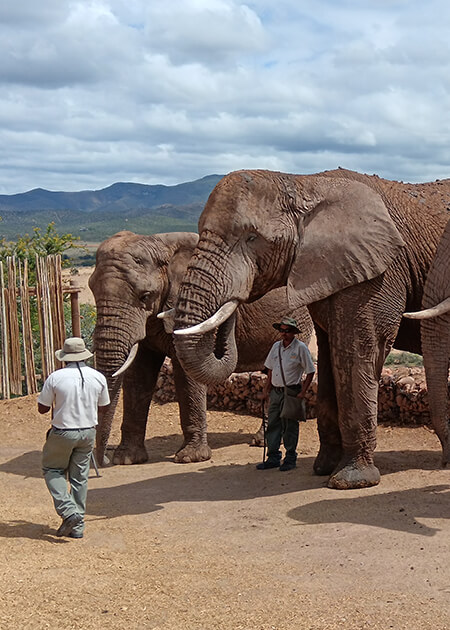
Then back on the motorbike and back to the ocean.
We joined the R62 again on the N9. The charm of the N9 is a 27 km long straight stretch. Just straight, straight and straight… and then the hills and the twists and turns again until we reached the easternmost part of the tour, the melodiously named Tsitsikamma National Park, where we even motorcycled through a beautiful, vast pine forest. Of course, we didn’t miss the chance to walk across the suspension bridge system over the river to the other side. And the Strorms River Bridge, with its breathtakingly lacy oceanfront, is famous for being the highest place to scream into the canyon below, as it has the world’s longest (216m!) bungee jump. The restaurant on the opposite side of the park televised the “death-defying” spectacle of those preparing to jump… and there was a queue!!!
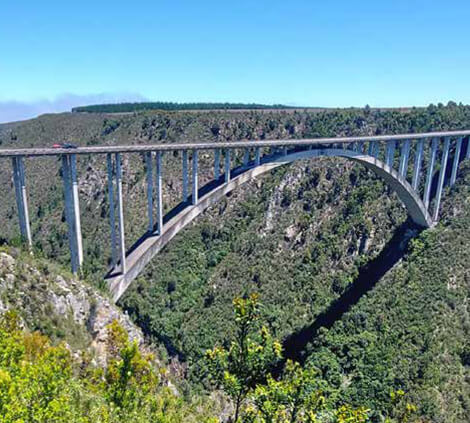
Barrydale was an important junction and an unmissable part of the tour,
for several reasons. Firstly, it is leading the wonder canony to the Tradouw Pass, secondly, it’s the site of the annual Harley Festival (HarleyDale), and thirdly, it’s home of the most famous brandy distillery in the area, the Joseph Barry Distillery. A small but famous distillery, where we tasted white, milk and dark chocolate with brandies of different vintages. Fourthly, there was our accommodation at the famous Karoo Art Hotel, where every floor, wall and floor, is covered with works by South African artists. Fine art (sculptures, very colourful paintings, graphics) has a long tradition in Africa anyway. You can buy some of them if you like!
On the way back to Cape Town, we visited one of the most famous wineries in the South African wine region, Ou Meul-t.l(Du Toits Kloof Wine Estate). Our passengers, of course, immediately jumped at the chance to taste some wine. Small group wine tasting is very easy. You get an A4 sheet of paper, filled with pictures of the wines available there. You tick the five (white/red) that most excite your imagination, and after a few minutes a sommelier appears and introduces the small group to the flavours you’ve chosen. You can swirl the glass, look at the ”skirt of the wine” and then sip, sip and sip and sip, again … On our trip, when we drank wine, we usually chose the pride of the South, the emblematic red of the region, Pinotage. (Pinotage is the only South African-bred grape variety to have an international career.) The 2021 “Granite” is also available in this country for around € 20.

Ahead of us was the Du Toits Kloof Pass, wedged between grey and red rocks, with beautiful bends, which we then “overcame” and rolled into GS Africa to drop the bikes. Fortunately, all the bikes were returned undamaged, so after signing the minutes and getting our deposit fully back, we were happy to smile saying:”.. this trip had been a very good one “!
And it was good! Even memorable one!
We had spent 2 weeks in the African summer, escaping the winters of our home country and experiencing the unique landscapes, people, animals, food and culture.
We spent our last day without bikes in Cape Town.
We had lunch in the Bo-Kaap district, world-famous for its colourful houses, in a Muslim family ‘eatery’ (the largest Muslim community in Cape Town ) and in the afternoon we walked to the always bustling harbour district, full of vendors and musicians, dancers. In the evening, we said goodbye to South Africa by watching the sunset on the city’s most famous beach, Camp Bay Beach, and while we were there, we of course stopped for dinner at the local Hard Rock Cafe. Of course we had steak…
Unfortunately, we couldn’t make it to Cape Town’s emblematic site, Table Mountain, which towers over the city. In the few days we spent in the city, there was never once a day without wind or clouds to get the lifts going. Well…! Next time !!
Let’s say we were in South Africa.
Of course, this is only a partial truth. We have been, but only in two corners of it, the southernmost two provinces, the Western Cape and the Eastern Cape. True, these two provinces have some of the most beautiful scenery in the world.
During the trip we never felt that we should be afraid or that we were unsafe. The tour organizers there knew exactly where to take us and what to show us. South Africa is now putting a lot of energy to show and let the world discovering the country. They are very attentive to the foreigners who visit.
On a difficulty scale of 5, this trip is rated ‘easy’, a 2. We didn’t have to move out of our usual motorcycle comfort zone, except for the left-hand traffic. In fact! The excellent quality of the roads even improved on that. The couples on the big bikes did not find obstacles in their stride, however, we covered the 2.000 kilometres in comfort, with plenty of time to see and try out leisurely all the good things…
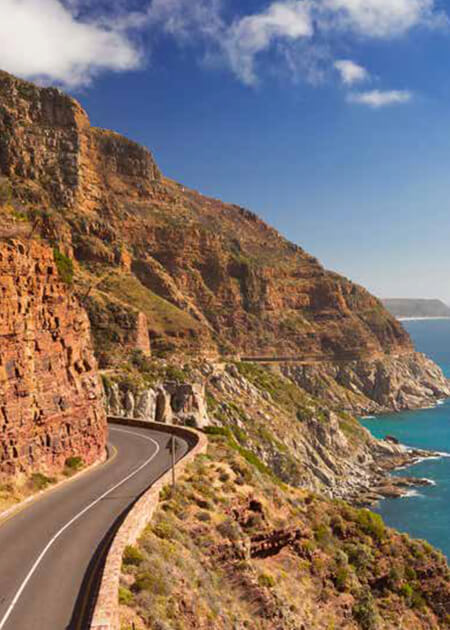
But there’s still plenty of motorcycling to be done in that vast country. As well as the equally leisurely, comfortable ride, the scenery and terrain are perfect for a more harder, rough combined on/off-road experience, covering even more kilometres, and once we’ve covered it, a short flight takes us to Kruger National Park, where we can really meet the big game, and the famous Victoria Falls…
I’m going to try them out, so:
I’m going back! Will you come with me?
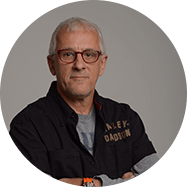
Author: Sandor Buza
columnist, radio reporter, journalist

